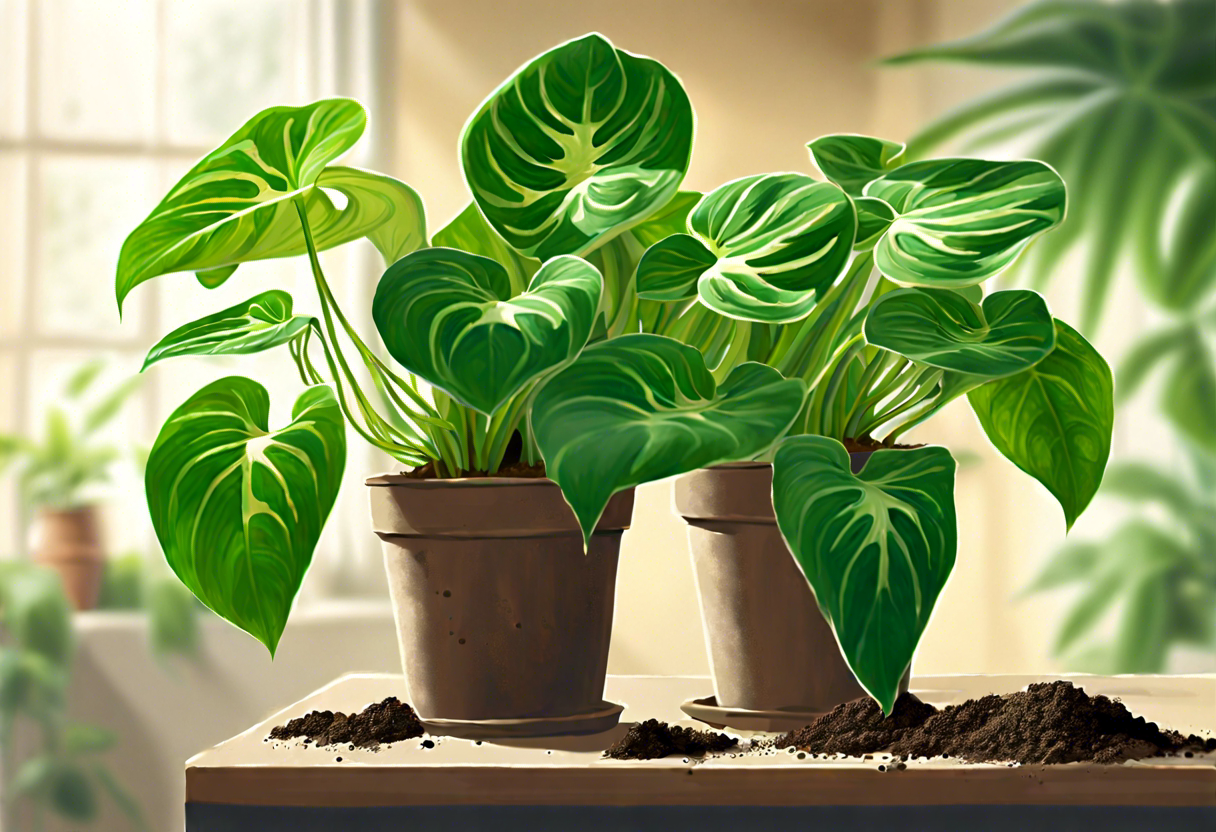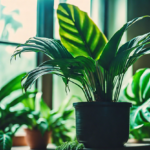The Importance of Choosing the Right Soil or Potting Mix for Pothos (Epipremnum aureum)
When it comes to keeping your Pothos (Epipremnum aureum) thriving and healthy, choosing the right soil or potting mix is of utmost importance. Pothos is a popular houseplant known for its trailing vines and attractive, heart-shaped leaves. To ensure optimal growth and prevent any potential problems, it is essential to understand the specific needs of Pothos in terms of soil quality.
Pothos is a tropical plant native to the Solomon Islands and prefers a well-draining and nutrient-rich soil. It is important to provide a potting mix that allows for proper water drainage, as Pothos plants are susceptible to root rot if they sit in waterlogged soil for an extended period. A well-draining soil mix ensures that excess water can easily escape, preventing the roots from becoming waterlogged.
In addition to good drainage, Pothos plants also require a potting mix that retains moisture while allowing the roots to breathe. A mix that strikes the right balance between water retention and aeration is crucial for the overall health of the plant. A soil mix that holds too much water may lead to root rot, while a mix that dries out too quickly can result in stressed and wilted plants.
To meet these requirements, it is advisable to use a high-quality potting mix specifically formulated for indoor plants or tropical foliage. These mixes are often lightweight and well-draining, allowing for proper air circulation around the roots. They are typically composed of a combination of organic materials such as peat moss, coconut coir, and perlite or vermiculite. These components provide both water retention and aeration properties necessary for healthy root development.
Alternatively, you can create your own DIY potting mix for Pothos by combining equal parts of peat moss or coconut coir, perlite or vermiculite, and a small amount of well-aged compost. This homemade mix provides the necessary nutrients, water retention, and aeration required by Pothos plants.
When repotting your Pothos, it is essential to choose a pot that allows for proper drainage. Select a pot with drainage holes at the bottom to ensure excess water can escape easily. This will help prevent overwatering and potential root rot.
Choosing the right soil or potting mix for your Pothos is crucial for its overall health and growth. A well-draining and nutrient-rich mix tailored to the specific needs of Pothos will ensure optimal conditions for the roots, preventing issues such as root rot. Whether you opt for a commercial potting mix or create your own, providing the ideal soil environment will help your Pothos thrive and bring beauty to your indoor space.
The Importance of Choosing the Right Soil or Potting Mix for Pothos (Epipremnum aureum)
Selecting the correct soil or potting mix is crucial for the health and growth of your Pothos (Epipremnum aureum). As a popular houseplant known for its vibrant foliage and easy care requirements, Pothos thrives when provided with the appropriate soil conditions. Understanding the specific needs of Pothos in terms of soil quality will help ensure that your plant remains healthy and flourishes in its environment.
Pothos plants prefer a well-draining soil that retains some moisture while allowing excess water to flow away. A mixture that combines quality potting soil with other organic components, such as peat moss or coconut coir, provides an ideal foundation for your Pothos. This type of soil composition ensures adequate drainage, preventing waterlogged roots and potential root rot, which can be detrimental to the plant’s overall health.
The soil pH level is another critical factor to consider when selecting a potting mix for Pothos. Ideally, the pH level should be slightly acidic to neutral, ranging between 6.0 and 7.0. This range allows for optimal nutrient uptake by the plant’s roots and ensures that essential minerals are readily available to support healthy growth. Testing the pH level of the soil using a simple soil test kit will help you determine if any adjustments are needed.
When exploring different types of potting mixes suitable for Pothos, you may come across various pre-packaged options available in garden centers. Look for potting mixes specifically labeled for houseplants or tropical plants, as they often contain the right balance of organic matter and moisture retention properties. These commercial mixes are typically formulated to provide adequate airflow and root aeration, allowing your Pothos to thrive.
If you prefer creating a DIY potting mix for your Pothos, consider blending equal parts of potting soil, peat moss, and perlite or vermiculite. The combination of potting soil provides necessary nutrients, while peat moss enhances water retention, and perlite or vermiculite ensures proper drainage. The result is a well-balanced soil mix that supports healthy root development and overall plant growth.
When choosing soil or potting mix for your Pothos, it is essential to avoid common mistakes that could hinder the plant’s well-being. Avoid using garden soil in pots, as it lacks the necessary drainage properties and may contain pests or diseases. Additionally, refrain from over-watering, as excessive moisture can lead to root rot.
Selecting the best soil or potting mix for Pothos is crucial for its overall health and growth. By understanding the specific needs of Pothos in terms of soil quality, you can provide the optimal conditions for your plant. Whether you opt for a commercial potting mix or create your own DIY blend, ensuring proper drainage, pH level, and nutrient availability will contribute to a thriving Pothos plant.
Exploring Different Types of Potting Mixes Suitable for Pothos
When it comes to growing Pothos (Epipremnum aureum), choosing the right potting mix is crucial for its success. Pothos is a popular houseplant known for its ability to thrive in various conditions. To ensure optimal growth and health, it’s important to understand the specific needs of Pothos in terms of soil quality and explore different types of potting mixes that are suitable for this versatile plant.
One popular option for potting mix is a well-draining soil mix. Pothos plants prefer a soil mix that allows excess water to drain freely. This helps prevent waterlogging, which can lead to root rot and other issues. A well-draining soil mix typically consists of a combination of organic matter such as peat moss or coconut coir, perlite, and sand. This combination helps create a light and airy soil mix that retains enough moisture for the plant’s needs while allowing excess water to escape.
Another option is a soilless potting mix, which is made up of various organic materials but does not contain soil. This type of mix is lightweight and promotes excellent drainage. Soilless potting mixes often consist of components such as peat moss, vermiculite, and perlite. These materials provide nutrients, retain moisture, and allow for adequate aeration. Soilless potting mixes are well-suited for Pothos as they provide a good balance between water retention and drainage.
Some gardeners prefer to create their own potting mix for Pothos. A DIY potting mix allows for customization and ensures that the soil meets the specific needs of the plant. A basic recipe for a DIY potting mix includes equal parts peat moss or coconut coir, perlite, and vermiculite. This combination provides a well-draining mix while retaining enough moisture for Pothos. Additionally, adding some organic matter, such as compost or well-rotted manure, can provide extra nutrients for the plant.
It’s important to note that Pothos can tolerate a wide range of soil conditions. However, it’s best to avoid heavy or compacted soils as they can hinder root growth and drainage. Additionally, using a pot with drainage holes is essential to prevent water from pooling at the bottom, which can lead to root rot.
Choosing the right potting mix for Pothos is essential for its overall health and growth. Whether opting for a well-draining soil mix, a soilless potting mix, or a DIY potting mix, the key is to provide a balance between moisture retention and drainage. By understanding the specific needs of Pothos and exploring different options, you can ensure that your plant thrives in its potting mix and remains vibrant and lush.
Tips for Creating a DIY Potting Mix for Pothos
Creating a DIY potting mix for your Pothos (Epipremnum aureum) can be a rewarding and cost-effective way to provide the best soil for your plants. By customizing the blend of ingredients, you can ensure that your Pothos receives the ideal balance of nutrients, moisture retention, and drainage. Follow these useful tips to create a DIY potting mix that will help your Pothos thrive.
-
Choose the Right Components: A good potting mix for Pothos should be well-draining while retaining enough moisture for the roots. Start by combining equal parts of peat moss, perlite, and vermiculite. Peat moss helps retain moisture, perlite improves drainage, and vermiculite aids in water retention.
-
Incorporate Organic Matter: Adding organic matter to your DIY potting mix will promote healthy root growth and provide essential nutrients. Consider incorporating compost or well-rotted manure into the mixture. This will enhance the soil’s fertility and improve moisture retention.
-
Include a Balanced Fertilizer: Pothos plants thrive when provided with a balanced fertilizer. Choose a slow-release fertilizer that contains equal parts of nitrogen, phosphorus, and potassium (N-P-K). This will ensure that your plant receives adequate nutrition over an extended period.
-
Don’t Overdo It with Fertilizer: While fertilizing is important, it’s crucial not to overdo it. Too much fertilizer can burn the roots and lead to nutrient imbalances. Follow the recommended dosage on the fertilizer packaging or dilute it to half-strength.
-
Ensure Proper Drainage: Adequate drainage is vital for Pothos plants. To enhance drainage, you can add coarse sand or small pieces of bark to the potting mix. This will prevent waterlogging, which can cause root rot and other problems.
-
Consider pH Levels: Pothos plants prefer slightly acidic to neutral soil. Aim for a pH level between 6.0 and 7.0. You can check the pH of your potting mix using a pH testing kit available at garden centers. If the pH is too high or too low, you can adjust it using organic soil amendments such as pine needles for acidity or dolomite lime for alkalinity.
-
Sterilize the Potting Mix: Before using your DIY potting mix, it’s important to sterilize it to eliminate any pathogens or pests. You can do this by baking the mixture at a low temperature (around 180°F) for 30 minutes or by microwaving it for several minutes.
-
Moisture Retention: Pothos plants prefer to be kept evenly moist but not waterlogged. Ensure that your potting mix retains enough moisture by misting the leaves regularly and checking the moisture level in the soil. Consider using a moisture meter to gauge when it’s time to water.
By following these tips, you can create a DIY potting mix that caters to the specific needs of your Pothos plant. Remember to observe your plant closely and adjust the watering frequency and fertilization based on its response. With the right potting mix, your Pothos will flourish and bring beauty to your indoor space.
Common Mistakes to Avoid When Choosing Soil or Potting Mix for Pothos
When it comes to caring for your Pothos (Epipremnum aureum), choosing the right soil or potting mix is crucial. The quality of the soil directly affects the health and growth of the plant. However, there are certain mistakes that many people make when selecting soil for their Pothos. Avoiding these common errors will help ensure that your plant thrives and remains healthy for years to come.
One of the most common mistakes is using regular garden soil for Pothos. While it may seem convenient, garden soil is often too heavy and lacks the proper drainage that Pothos requires. The dense soil can hold excess water, leading to root rot and other moisture-related issues. Instead, opt for a well-drained potting mix specifically designed for houseplants.
Another mistake is using soil that retains too much moisture. Pothos prefers soil that is slightly moist but not overly wet. Using moisture-retaining soil can lead to overwatering, causing the roots to suffocate and rot. Look for a potting mix that allows for proper aeration and drainage, such as one that contains perlite or vermiculite.
It’s important to avoid using low-quality potting mixtures that contain a high percentage of sand or clay. These types of soil retain water excessively, preventing proper airflow to the plant’s roots. This can lead to waterlogging and root rot. Instead, choose a potting mix that is lightweight, well-draining, and formulated specifically for indoor plants.
Additionally, many people make the mistake of not checking the pH level of the soil. Pothos prefers slightly acidic soil with a pH range of 6.0 to 7.0. Using soil with an incorrect pH level can affect the plant’s nutrient absorption and overall health. Conduct a pH test using a soil testing kit to ensure the soil is within the optimal range for your Pothos.
One last mistake to avoid is using old or stale potting mix. Over time, potting mix can become compacted, reducing its ability to drain water efficiently. It may also lose valuable nutrients necessary for the plant’s growth. When repotting your Pothos, always use fresh potting mix to provide the best growing environment.
Selecting the right soil or potting mix for your Pothos is essential for its well-being. Avoiding common mistakes such as using regular garden soil, soil that retains too much moisture, low-quality potting mixtures, incorrect pH levels, and old potting mix will go a long way in promoting healthy growth for your Pothos plant. By providing the optimal soil conditions, your Pothos will flourish and bring beauty to your home or office space.
Conclusion
Choosing the right soil or potting mix for Pothos (Epipremnum aureum) is crucial for the health and growth of these popular houseplants. By understanding the specific needs of Pothos in terms of soil quality, we can provide them with an environment that promotes optimal growth and thriving. Exploring different types of potting mixes suitable for Pothos allows us to find the one that best suits our preferences and the needs of our plants. Alternatively, we can create a DIY potting mix for Pothos, tailoring it to their specific requirements. However, it’s important to be aware of common mistakes to avoid when choosing soil or potting mix for Pothos, as these can negatively impact their well-being.
The importance of choosing the right soil or potting mix for Pothos cannot be overstated. Providing them with a suitable medium promotes healthy root development, proper drainage, and sufficient aeration. This, in turn, enhances the overall growth and vitality of the plant. Pothos require a well-draining soil that retains moisture without becoming waterlogged, striking the perfect balance for their optimal growth.
Understanding the specific needs of Pothos in terms of soil quality is essential. These plants prefer a slightly acidic to neutral pH range, typically between 6.0 and 7.0. Additionally, Pothos thrive in loose, well-draining soil that allows for airflow around the roots. A combination of these factors will ensure that the plant receives the necessary nutrients and moisture without the risk of root rot or suffocation.
There are different types of potting mixes that are suitable for Pothos. One option is a general-purpose potting mix, which often contains a blend of organic matter, such as peat moss or compost, with the addition of perlite or vermiculite to improve drainage. This type of mix provides a good foundation for Pothos and is readily available in most garden centers.
Another option is a specialized soil mix designed specifically for tropical plants. These mixes often contain a higher proportion of organic matter, such as coir or bark chips, and are formulated to retain moisture while still allowing for proper drainage. This can be beneficial for Pothos, as it replicates their natural habitat and helps them thrive.
For those who prefer a hands-on approach, creating a DIY potting mix for Pothos is a viable option. A simple recipe can involve combining equal parts of peat moss or coir, perlite or vermiculite, and compost or worm castings. This mixture provides a balanced blend of organic matter, drainage, and nutrients, catering to the specific needs of Pothos. Experimenting with different ratios or adding amendments, such as coconut husk chips or charcoal, can further personalize the mix to suit individual preferences.
When choosing soil or potting mix for Pothos, it is important to avoid common mistakes that can hinder their growth. One common error is using heavy, compacted soil that retains water, leading to root rot. Another mistake is overwatering, as Pothos prefer to dry out between waterings. Additionally, it’s crucial to avoid using soil from the garden, as it may contain pests or diseases that can harm the plants.
By taking the time to understand the importance of choosing the right soil or potting mix for Pothos, we can cultivate healthy and thriving plants. Whether opting for a commercially available potting mix or creating a customized DIY blend, providing the proper soil for Pothos is pivotal for their growth and overall well-being. By avoiding common mistakes and adhering to their specific needs, we can enjoy the beauty and benefits of these lush and captivating houseplants for years to come.


